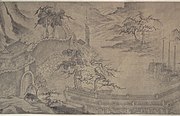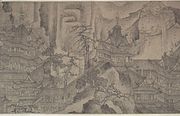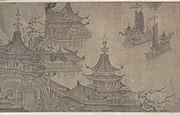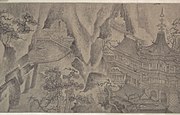Daming Palace
大明宫国家遗址公园 | ||
Hanyu Pinyin | dàmíng gōng guójiā yízhǐ gōngyuán | |
The Daming Palace was the imperial palace complex of the
Name
The palace was originally known as Yong'an Palace but was renamed to Daming Palace in 635.[8][9] In 662, after renovations to the palace, it was renamed Penglai Palace.[8][9] In 670, it was renamed Hanyuan Palace[9] or Yuan Palace.[8] Eventually, in 701, the name was changed to Daming Palace again.[8][9]
History
The former royal residence was the Taiji Palace (太極宮), built in the previous Sui dynasty.[10]
In 632, chancellor Ma Zhou charged that the retired Emperor Gaozu was living in Da'an Palace (大安宮) to the west, which he considered an inhospitable place as it was built on low-lying lands of Chang'an that was plagued by dampness and heat during the summer.[11] According to him, ever since Emperor Taizong moved to the countryside during the summers, his retired father was left behind in Chang'an to suffer in the summer heat.[11] However, his father would always decline any invitation from Emperor Taizong to spend the summer together.[11] Ever since the bloody palace coup of the Xuanwu Gate Incident in 626, it seemed that father and son had drifted apart to an extent that their relationship never healed.[11]
In 634, Emperor Taizong launched the construction of the Daming Palace at Longshou Plateau.[12][13] He ordered the construction of the summer palace for his retired father, Emperor Gaozu, as an act of filial piety.[14] However, Emperor Gaozu grew ill and never witnessed the palace's completion before his death in 635,[11] and construction halted thereafter.
Empress Wu commissioned the court architect Yan Liben to design the palace in 660 and construction commenced once again in 662.[14] In 663, the construction of the palace was completed under the reign of Emperor Gaozong.[15] Emperor Gaozong had launched the extension of the palace with the construction of the Hanyuan Hall in 662, which was finished in 663. On 5 June 663, the imperial family began to relocate from the Taiji Palace into the yet to be completed Daming Palace,[16] which became the new seat of the imperial court and political center of the empire.[9][16][17]
Layout and function

Beginning from the south and ending in the north, on the central axis, stand the Hanyuan Hall, the Xuanzheng Hall, and the Zichen Hall.[8] These halls were historically known as the "Three Great Halls" and were respectively part of the outer, middle, and inner court.[8] The central southern entrance of the Daming Palace is the Danfeng Gate.[1] The gate consisted of five doorways.[18]
The present site covers more than 4,800
Outer court
After passing through the Danfeng Gate, there is a square of 630 metres (2,070 ft) long with at the end the Hanyuan Hall.[20] The Hanyuan Hall was connected to pavilions by corridors, namely the Xiangluan Pavilion in the east and the Qifeng Pavilion in the west.[8][21] The pavilions were composed of three outward-extending sections of the same shape but different size that were connected by corridors.[21] The elevated platform of the Hanyuan Hall is approximately 15 metres (49 ft) high, 200 metres (660 ft) wide, and 100 metres (330 ft) long.[7] The Hanyuan Hall, where many state ceremonies were conducted, would serve as the main hall for hosting foreign ambassadors during diplomatic exchanges.[7]
-
Reconstruction model of Hanyuan Hall
-
Hanyuan Hall's platform
-
Hanyuan Hall's platform
Middle court
The Xuanzheng Hall is located at a distance of about 300 metres (980 ft) north of the Hanyuan Hall.
Inner court
The Zichen Hall, located in the inner court,
The Linde Hall is located to the west of the lake.
-
Model of the Linde Hall
-
Linde Hall's platform
Border
The area around the palace complex grounds is currently planted with locust trees, willows, flowers, and bushes on all sides.[26]
Heritage

The site of the Daming Palace was discovered in 1957.[28] Between 1959 and 1960, the earliest surveys and excavations of the Hanyuan Hall site were carried out by the Institute of Archaeology of the Chinese Academy of Sciences.[21]
On 1 October 2010, the Daming Palace National Heritage Park was opened to the public.[30] There are many exhibition halls located throughout the site of the palace complex to showcase the excavated cultural relics of the site.[8]
Gallery
-
Daming Palace, attributed to Wang Zhenpeng (fl. 1275-1330) but likely 15th century production
See also
- Huang Chao, whose revolt caused the destruction of the palatial complex
References
- ^ a b "Site of Danfeng Gate". ICOMOS International Conservation Center. Archived from the original on 23 April 2015. Retrieved 7 January 2012.
- ^ Chung, Saehyang. "A Study of the Daming Palace: Documentary Sources and Recent Excavations". Artibus Asiae, Vol. 50, No. 1/2 (1990), pp. 23–72. Accessed 15 November 2013.
- ^ ISBN 978-7-5054-0507-3.
- ^ "Stories of Daming Palace". China Daily. p. 2. Retrieved 7 January 2012.
- ISBN 978-981-4287-76-0.
- ^ "Silk Roads: the Routes Network of Chang'an-Tianshan Corridor". UNESCO World Heritage Centre. Retrieved 24 August 2023.
- ^ ISBN 978-1-60606-013-1.
- ^ Ministry of Culture of the People's Republic of China. Archived from the originalon 1 December 2015. Retrieved 18 December 2011.
- ^ a b c d e "Daming Palace Site". Cultural China. Archived from the original on 12 June 2015. Retrieved 18 December 2011.
- ^ "Birth of fantasy". Daming Palace. Episode 1. 7 minutes in. China Central Television. CCTV-9. Archived from the original on 24 January 2012. Retrieved 7 January 2012.
- ^ ISBN 0-521-21446-7.
- ISBN 978-0-674-05608-4.
- ISBN 978-9971-69-223-0.
- ^ a b "The missing ancient architectures Part 3- Eternal regrets of the Daming Palace". China Central Television. Archived from the original on 22 January 2012. Retrieved 21 December 2011.
- ISBN 978-0-8047-1587-4.
- ^ a b "Birth of fantasy". Daming Palace. Episode 1. 24–26 minutes in. China Central Television. CCTV-9. Archived from the original on 24 January 2012. Retrieved 7 January 2012.
- ^ "Conference 'Daming Palace and the Tang Dynasty'". Oxford Archaeology. Archived from the original on 19 October 2011. Retrieved 18 December 2011.
- ^ "Archaeologists find ancient palace gate". ABC News. 4 December 2005. Retrieved 7 January 2012.
- ^ "The Palace of Palaces". english.china.com. Retrieved 21 June 2021.
- ^ "Birth of fantasy". Daming Palace. Episode 1. 26 minutes in. China Central Television. CCTV-9. Archived from the original on 24 January 2012. Retrieved 7 January 2012.
- ^ a b c d Hanyuan Hall of Daming Palace, Beijing: UNESCO Beijing Office, 1998
- ^ "Birth of fantasy". Daming Palace. Episode 1. 37 minutes in. China Central Television. CCTV-9. Archived from the original on 24 January 2012. Retrieved 7 January 2012.
- ^ a b c d "Birth of fantasy". Daming Palace. Episode 1. 39–41 minutes in. China Central Television. CCTV-9. Archived from the original on 24 January 2012. Retrieved 7 January 2012.
- ^ a b c d "Daming Palace". AncientWorlds LLC. Archived from the original on 4 December 2008. Retrieved 18 December 2011.
- ^ a b "Original site of Daming Palace". China Daily. Retrieved 7 January 2012.
- ^ a b China Daily. "Brief Introduction of Daming Palace National Heritage Park". 2010. Accessed 15 November 2013.
- ^ a b "Linde Hall". Cultural China. Archived from the original on 3 May 2010. Retrieved 18 December 2011.
- ^ a b "Empress of the dynasty". Daming Palace. Episode 3. 49–51 minutes in. China Central Television. CCTV-9. Archived from the original on 26 January 2012. Retrieved 19 December 2011.
- ^ a b "Hanyuan Hall of the Daming Palace of the Tang Dynasty, China". Permanent Delegation of Japan to UNESCO. Retrieved 18 December 2011.
- ^ "Daming Palace preservation project". China Daily. Retrieved 7 January 2012.















